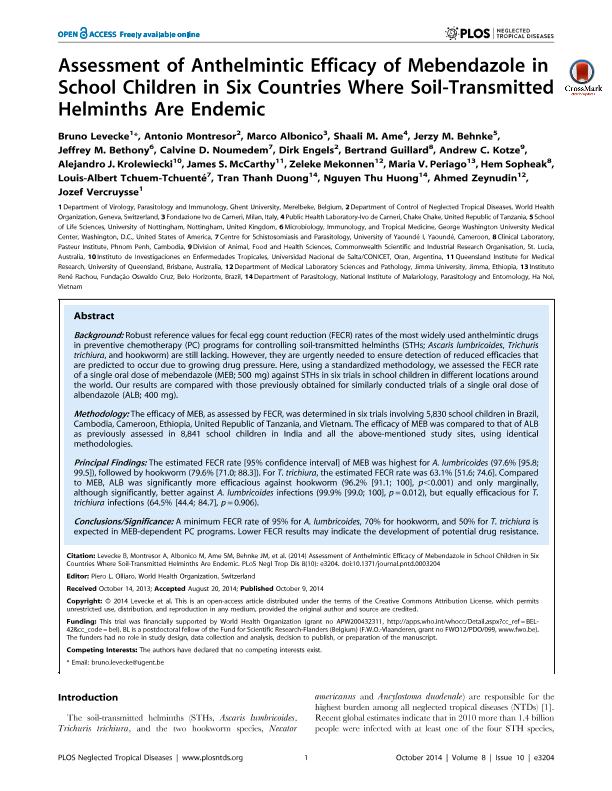Artículo
Assessment of Anthelmintic Efficacy of Mebendazole in School Children in Six Countries Where Soil-Transmitted Helminths Are Endemic
Levecke, Bruno; Montresor, Antonio; Albonico, Marco; Ame, Shaali M.; Behnke, Jerzy M.; Bethony, Jeffrey M.; Noumedem, Calvine D.; Engels, Dirk; Guillard, Bertrand; Kotze, Andrew; Krolewiecki, Alejandro Javier ; McCarthy, James; Mekonnen, Zeleke; Periago, Maria V.; Sopheak, Hem; Tchuem Tchuente, Louis Albert; Duong, Tran Thanh; Huong, Nguyen Thu; Zeynudin, Ahmed; Vercruysse, Jozef
; McCarthy, James; Mekonnen, Zeleke; Periago, Maria V.; Sopheak, Hem; Tchuem Tchuente, Louis Albert; Duong, Tran Thanh; Huong, Nguyen Thu; Zeynudin, Ahmed; Vercruysse, Jozef
 ; McCarthy, James; Mekonnen, Zeleke; Periago, Maria V.; Sopheak, Hem; Tchuem Tchuente, Louis Albert; Duong, Tran Thanh; Huong, Nguyen Thu; Zeynudin, Ahmed; Vercruysse, Jozef
; McCarthy, James; Mekonnen, Zeleke; Periago, Maria V.; Sopheak, Hem; Tchuem Tchuente, Louis Albert; Duong, Tran Thanh; Huong, Nguyen Thu; Zeynudin, Ahmed; Vercruysse, Jozef
Fecha de publicación:
10/2014
Editorial:
Public Library Of Science
Revista:
Neglected Tropical Diseases
ISSN:
1935-2735
Idioma:
Inglés
Tipo de recurso:
Artículo publicado
Clasificación temática:
Resumen
Background: Robust reference values for fecal egg count reduction (FECR) rates of the most widely used anthelmintic drugsin preventive chemotherapy (PC) programs for controlling soil-transmitted helminths (STHs; Ascaris lumbricoides, Trichuristrichiura, and hookworm) are still lacking. However, they are urgently needed to ensure detection of reduced efficacies thatare predicted to occur due to growing drug pressure. Here, using a standardized methodology, we assessed the FECR rateof a single oral dose of mebendazole (MEB; 500 mg) against STHs in six trials in school children in different locations aroundthe world. Our results are compared with those previously obtained for similarly conducted trials of a single oral dose ofalbendazole (ALB; 400 mg).Methodology: The efficacy of MEB, as assessed by FECR, was determined in six trials involving 5,830 school children in Brazil,Cambodia, Cameroon, Ethiopia, United Republic of Tanzania, and Vietnam. The efficacy of MEB was compared to that of ALBas previously assessed in 8,841 school children in India and all the above-mentioned study sites, using identicalmethodologies.Principal Findings: The estimated FECR rate [95% confidence interval] of MEB was highest for A. lumbricoides (97.6% [95.8;99.5]), followed by hookworm (79.6% [71.0; 88.3]). For T. trichiura, the estimated FECR rate was 63.1% [51.6; 74.6]. Comparedto MEB, ALB was significantly more efficacious against hookworm (96.2% [91.1; 100], p,0.001) and only marginally,although significantly, better against A. lumbricoides infections (99.9% [99.0; 100], p = 0.012), but equally efficacious for T.trichiura infections (64.5% [44.4; 84.7], p = 0.906).Conclusions/Significance: A minimum FECR rate of 95% for A. lumbricoides, 70% for hookworm, and 50% for T. trichiura isexpected in MEB-dependent PC programs. Lower FECR results may indicate the development of potential drug resistance
Palabras clave:
Mebendazol
,
Trichuris Trichiura
,
Ascaris Lumbricoides
,
Hookworm
Archivos asociados
Licencia
Identificadores
Colecciones
Articulos(IPE)
Articulos de INST.DE PATOLOGIA EXPERIMENTAL
Articulos de INST.DE PATOLOGIA EXPERIMENTAL
Citación
Levecke, Bruno; Montresor, Antonio; Albonico, Marco; Ame, Shaali M.; Behnke, Jerzy M.; et al.; Assessment of Anthelmintic Efficacy of Mebendazole in School Children in Six Countries Where Soil-Transmitted Helminths Are Endemic; Public Library Of Science; Neglected Tropical Diseases; 8; 10; 10-2014; 1-12
Compartir
Altmétricas



